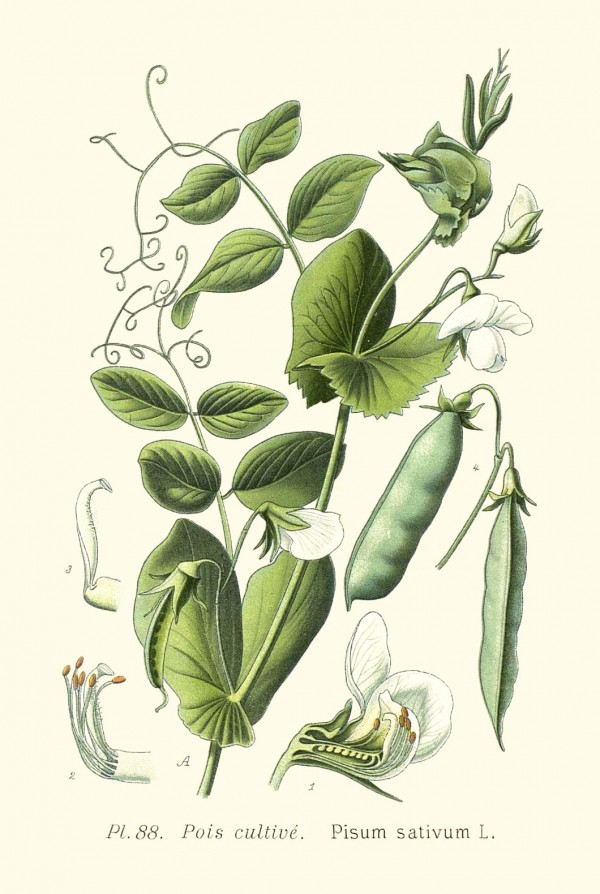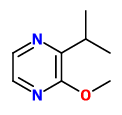Pisum sativum L. syn. Pisum arvense L. - Fabaceae - pea, Erbse, Saat-Erbse, Gartenerbse
Annual herb with up to 2m long climbing stem; leaves stipules to 10×6cm, margin toothed; leaflets up to 4 pairs of leaflets ending in a tendril which is usually branched; racemes axillary, 1-3-flowered; corolla variable in color, white to purple; fruit a pendent oblong pod, up to 15cm long, containing up to 11 globose seeds (4-8mm in diam.).
http://www.efloras.org/florataxon.aspx?flora_id=2&taxon_id=200012282
„The origins of Pisum sativum are not very well known. Archaeological evidence found in the Fertile Crescent (the area surrounding modern day Israel and Jordan and the land in and around the Tigris and Euphrates rivers), indicates that people have been cultivating pea since 8,000 BC. Western Asia appears to be the area in which pea was first cultivated and from there it was spread by humans to Europe, China and India. Today, Pisum sativum , is grown in all temperate countries and in most tropical highlands.“
http://powo.science.kew.org/taxon/urn:lsid:ipni.org:names:60454055-2
By headspace examination of the salt-saturated juice from raw vegetable tissues, 2-methoxy-3-isopropylpyrazine has been found the most important pyrazine in pea seeds and especially in pea shells with the odour description 'green peas, bell pepper-raw potato, earthy bell pepper'.
[Murray, Keith E., and Frank B. Whitfield. „The occurrence of 3‐alkyl‐2‐methoxypyrazines in raw vegetables.“ Journal of the Science of Food and Agriculture 26.7 (1975): 973-986]
Of the 10 odorants detected in raw peas by GC-O, the highest OAV were calculated for 3-methylbutanoic acid (382; sweaty, rancid), hexanal (280), and (E)-2-octenal (8). Aroma recombination and omission experiments showed that a noticeable difference in aroma was perceived when hexanal and benzaldehyde were omitted from the model. „In addition, the omission of (E)-2-octenal, 3-methylbutanoic acid, (Z)-2-penten-1-ol, and benzyl alcohol resulted in significant changes in aroma.“
[Bi, Shuang, et al. „Characterization of key aroma compounds in raw and roasted peas (Pisum sativum L.) by application of instrumental and sensory techniques.“ Journal of Agricultural and Food Chemistry 68.9 (2020): 2718-2727]
The most potent flavor compound of raw pea milk was 2-methoxy-3-isopropyl-(5 or 6)-methylpyrazine, followed by hexanal, (E,E)-2,4-nonadienal, (E,E)-2,4-decadienal, 1-octen-3-ol, and 2-pentylfuran.
[Zhang, Caimeng, et al. „Key volatile off-flavor compounds in peas (Pisum sativum L.) and their relations with the endogenous precursors and enzymes using soybean (Glycine max) as a reference.“ Food Chemistry 333 (2020): 127469.]
„…pea aroma is a product of complex interactions of a large number of volatiles. The volatiles are either already present natively in the pea or are formed during harvesting/processing, indicating that often aroma profile changes are essentially caused by fat oxidation products.“
[Trindler, Christian, Katrin Annika Kopf-Bolanz, and Christoph Denkel. „Aroma of peas, its constituents and reduction strategies–Effects from breeding to processing.“ Food chemistry 376 (2022): 131892.]

Pisum sativum L.; A. Masclef, Atlas des plantes de France, vol.2 t.88
http://botanicalillustrations.org/species.php?id_species=800985
Pisum sativum, Nickelsdorf / Grundäcker 2008; author: Rolf Marschner,
www.botanische-spaziergaenge.at

